Servicios Personalizados
Revista
Articulo
Indicadores
-
 Citado por SciELO
Citado por SciELO -
 Accesos
Accesos
Links relacionados
-
 Similares en
SciELO
Similares en
SciELO
Compartir
Revista Latinoamericana de Desarrollo Económico
versión impresa ISSN 2074-4706versión On-line ISSN 2309-9038
rlde n.4 La Paz abr. 2005
TRABAJO DE INVESTIGACIÓN
Assessing Markets for Central American Products in U.S. Ethnic Communities (The Common Beans Case)
Miguel Zamora, Richard Bernsten*
Summary
At the end of 2003, the U.S. Census Bureau estimated that around 2.7 million people in the U.S. were of Central American origin. While this community represents a potential market for Central American exports, no study had previously been carried out to describe the ethnic markets for Central American products in the U.S. This paper describes the findings from research conducted in 2003, which suggests that people of Central American origin prefer to buy beans from their country of origin and are willing to pay a premium price for these beans. Also described in the paper is information to be used in future research for assessing the demand for food products from Latin America in U.S. ethnic communities.
Resumen
A finales de 2003, la Oficina del Censo de EE.UU. estimó que alrededor de 2.7 millones de personas en los EE.UU. eran de origen centroamericano. Mientras que esta comunidad representa un mercado potencial para las exportaciones centroamericanas, ningún estudio para describir los mercados étnicos para productos centroamericanos había sido realizado. Este documento describe resultados de una investigación conducida en 2003, que sugiere que las personas de origen centroamericano en EE.UU. prefieren comprar frijoles de su país de origen y están dispuestos a pagar un precio superior por este producto. En este documento también se describe información que puede ser utilizada en futuras investigaciones que deseen determinar la demanda para productos alimenticios latinoamericanos en comunidades étnicas de EE.UU.
1. Introduction
Hispanic1 households in the U.S. represent an important market for food products. According to the Food Marketing Institute (FMI), households of Hispanic origin spend an average of US$ 117 per week on groceries, compared to the average U.S. household which spends US$87 per week. Hispanics visit grocery stores an average of 4.7 times a week, compared to 2.2 times for the average American and 85 percent of the food eaten at home by Hispanic households is Hispanic food (FMI, 2002). Furthermore, in 2001 the Hispanic buying power in the U.S. was approximately US$452 billion, which is estimated to increase to US$653 billion by 2003 and to US$ 1,014.2 billion by 2008. This growth in buying power is projected to be relatively greater than for any other U.S. ethnic group (Humphreys, 2003).
During the past decade, the Hispanic population increased rapidly (from 22.3 million in 1990 to 35.3 million in 2000). Furthermore, this rate of increase (57.9 percent) was greater than the increase in the White non-Hispanic, African American, Asian and Native American groups. In 2002, Hispanics became the second largest population group in the U.S. by race or origin (U.S. Census Bureau, 2000). At the end of 2003, the U.S. Census Bureau estimated that around 7 percent of the U.S. Hispanic population (2.7 million people) was of Central American origin.
Anecdotal evidence suggests that there is a growing market in the U.S. for Hispanic products -primarily in cities with a high Hispanic population. For example, an analysis of Hispanic market trends reported that 69 percent of the U.S. Hispanic-American population say that they are more Hispanic than American (Cheskin Group, 2002). This attitude, which illustrates how much Hispanics embrace their heritage and identity, may explain why many Hispanics prefer to consume products that come from their country of origin.
Beans are widely consumed by both Hispanic and non-Hispanic households. According to Lucier, et al. (2000) on any given day, nearly 14 percent of Americans consume at least one meal containing cooked beans -the majority of which are prepared at the consumers' homes. However, Hispanics consume proportionally more cooked beans than any other ethnic group. While Hispanics accounted for more than 12 percent of the U.S. population in 2000, in 1998 they accounted for 33 percent of bean consumption.
Consumers of Central American origin (CAO) prefer beans with specific characteristics of taste, color and cooking time. A recent survey of 203 households of Salvadoran origin living in Houston and Los Angeles reported that, in a typical week, 89 percent of these households consumed about 3 pounds of red beans. Furthermore, 59 percent of the surveyed households reported that they would consume up to 3.6 pounds of Salvadoran red beans, if they were available for purchase (Batres-Marquez, Jensen, and Brester, 2001). Also, in 2003, the Salvadoran government estimated that the potential market for Salvadoran beans in the U.S. is around US$ 4.8 million (Ministerio de Economía de El Salvador, 2003). However, this figure was based on a Salvadoran population estimate that was significantly higher than the number reported in the Census 2000.
Trade liberalization creates new opportunities and risks to the food sector in Central America. However, globalization and diversification of consumers' preferences in the U.S. may also create new market opportunities for Central American (CAN) farmers and traders.
The current paper analyzes markets for Central American common beans (canned beans are not included) in U.S. communities with high concentration of Central Americans. Section two, describes the methodology used for the study as an example of how this methodology could be used in other similar studies. Section three details the geographic concentration of persons of Central American Origin (CAO) in the U.S. by state, county and cities with the highest concentration of this origin. Section four briefly documents the small red and black beans exports from Central America to the U.S. Section five describes the Central American origin bean sub-sector, focusing on the roles of the various participants. Section six discusses the constraints and opportunities facing Central American exporters who wish to target this niche market and increase their participation in it. Finally, Section seven summarizes the research findings, draws implications for policy-makers and bean suppliers in Central America, discusses the study's limitation, and identifies additional research that needs to be conducted.
2. Methodology
The rapid appraisal method could be used to assess the markets for products from a specific origin in U.S. ethnic communities. Secondary data could be analyzed to describe the distribution and concentration of people from a specific origin in the U.S. Also, key interviews could be conducted in the U.S. cities with the highest concentration of the specific origin to better understand the food market in ethnic communities in the U.S.
2.1 The Geographical Concentration of Hispanic Populations in the U. S.
Data from the 2000 Census could be used to identify the states and cities with the highest concentration of people of a specific origin. After identifying these states, counties within these states will be selected using the same criteria. Then, cities within these counties will be selected and tracked, using data from the same source. Census tracts2 are very specific, which makes it possible to identify streets and neighborhoods within cities with the highest concentration of people of a specific origin and then visit these areas to collect data. It is also useful to use Geographic Information System (GIS) software like ArcView® in order to map the tracts and streets within the selected cities with the highest concentration of each CAO group. During fieldwork, these maps are useful to identify and walk around the areas where Hispanic groceries are located (see Tracking Example below for an application of this methodology). The embassies or Consulates of the specific country should be visited to gather information about official programs to promote exports and regarding contact information for traders. In some cases, these visits also help to provide a general idea regarding the Hispanic food market and the spatial distributions of people of the specific origin in the U.S.
Tracking Example
In order to find the CAO grocery stores or other specific origin grocery stores in U.S. the following example could be used. Once it was determined the states, counties and cities within the U.S. with the highest concentration/population of people of CAO, the tracts with the highest populations of people of CAO are selected. As an example consider the Census Tract 54.02 of the Miami-Dade County in the State of Florida. In Figure 1, the colored little boxes represent the Census Tracts in the Miami-Dade County (the darker the box, the most populated by people of CAO the track is).
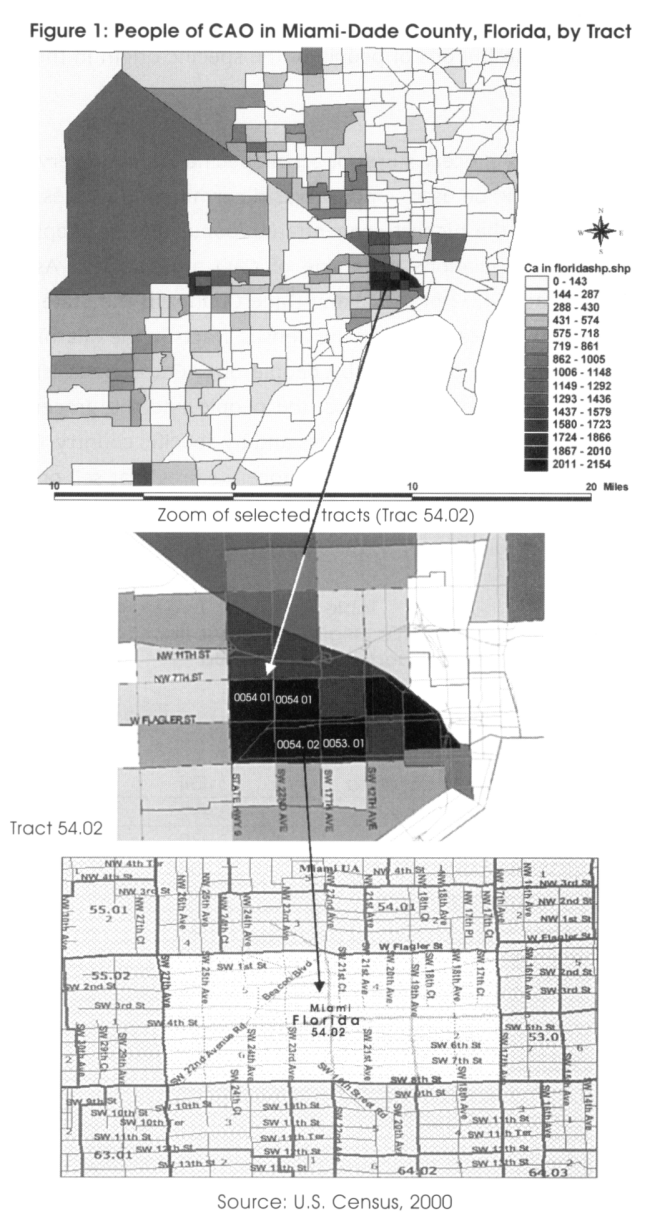
Using these maps and the information from the Census, the people and the grocery stores of a specific origin could be found by specific streets and by specific country. Creating these maps allow to visit these areas and to identify grocery stores that sell or are willing to sell food products from a specific origin. In our example, Table 1 shows the specific populations of the tract studied.
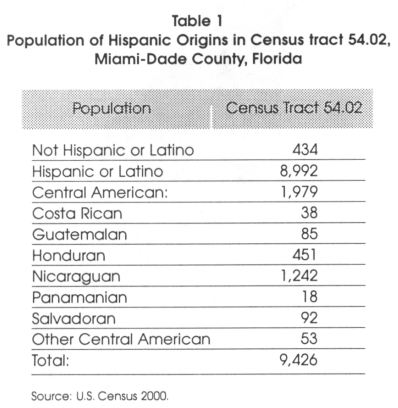
2.2 Food Trade Between Selected Countries and the U.S.
Secondary data (i.e., U.S.A. Trade on-line and ERS/USDA databases) could be analyzed to document trends in U.S. imports and exports of selected products of the specific country studied. For the common beans case, trade data from the U.S.A. Trade Online database was used to document the U.S.-Central America common beans trade. This database contains U.S. imports and exports information from the Foreign Trade Division of the U.S. Census Bureau.
2.3 Hispanic Grocers and Consumers Preferences
Hispanic Grocery Stores
To locate Hispanic grocery stores with a high ratio of consumers from the specific origin, it is sufficient to visit neighborhoods with the highest concentration of people of that specific origin. For this research, 30 grocery stores were visited and data were collected regarding the market classes of beans sold, the prices of black and small red beans, brands that target Hispanic consumers, the origin of these beans, and the names of the firms that supplied these brands to the grocery. In selected cases, information on consumers' preferences was also collected through informal talks with the grocery's manager or owner.
Consumers of Central American Origin
During the research trips, interviews could be conducted with a sample of persons from the specific origin. In the case of Central America, a sample of CAO consumers buying beans at Hispanic grocery stores or visiting Central American (CAN) consulates in the U.S. were interview regarding their bean consumption preferences.
Bean Distribution Chain
Interviews with U.S. distributors and importers of Hispanic food help to understand the current situation in the food markets and to identify the information that will be needed in order to increase exports of products from the specific country of origin. Contact information from distributors/importers can be obtained at embassies/consulates or attending food fairs like "Expo-Comida Latina".
This methodology could be used to assess markets for food products from different regions or countries in Latin America
3. The Geographical concentration of people of Central American origin in the U.S.
According to the 2000 U.S. Census data, over the last decade, the Hispanic population in the U.S. increased by 58 per cent (from 22.4 million in 1990 to 35.3 million in 2000), compared with an increase of only 13.2 percent for the total U.S. population (Table 2). During the same period, the CAO population in the U.S. increased by 27.4 percent. However, a 2003 Supplemental Census Survey conducted in 2001 estimated the CAO population to be 37.9 percent greater than the number reported in the 2000 Census.
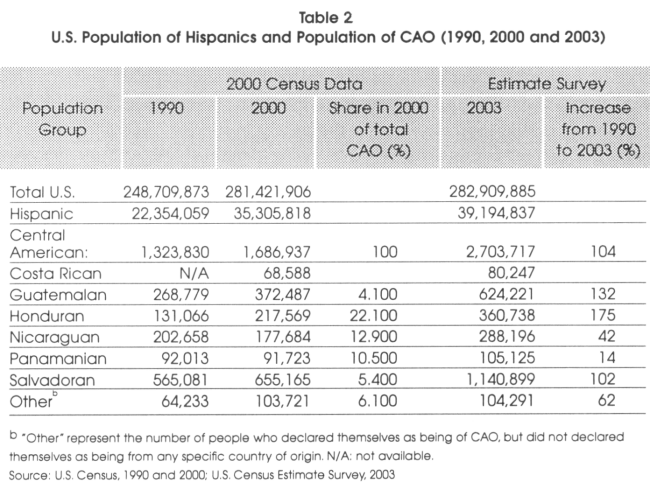
There is a big difference between the Census 2000 number reported and the 2003 estimate from the Census Bureau. Some Central American embassies' representatives suggested that it is possible that people of CAO participated in the 2003 survey more openly than in the Census since many illegal immigrants do not seem to like participating in the actual Census. Many illegal immigrants may fear that participating in the Census may cause them problems with the Immigration Service.
This latter point could also help to explain why the number of people of CAO origin reported by the U.S. Census Bureau is different than that estimated by the CAN embassies in the U.S. For example, the Salvadoran government estimated around 2.2 million Salvadorans living in the U.S. by 2002. In contrast, the 2001 estimate from the U.S. Census Bureau was around one million people of Salvadoran origin. However, the numbers from the Salvadoran government are based on estimates from the Salvadoran consulates in different cities. These numbers by city tend to be overestimated by the consulates. For example, the Salvadoran consulate estimated 450,000 Salvadorans living in San Francisco out of a total of 1.3 million Hispanics (they define San Francisco as the area of eleven counties that form San Francisco) (Ministerio de Economía de El Salvador, 2003). However, the population of Salvadoran origin in the "Bay Area" (the nine Bay Area counties in the San Francisco area) was estimated in less than 50,000 out of 1.3 million Hispanics by the U.S. Census 2000. Also, working with the numbers from the U.S. Census Bureau allowed analyzing the CAO populations by specific cities and tracts. In this way, the CAN governments can use the information about the concentration of CAO people in this document and they can still use their own estimates. The number people of a specific origin in a city could vary depending on the source of the information but the concentration of people of that origin (proportion of that origin as percentage of total population in the city) will probably not vary.
This document will use data from the census emphasizing the concentration and distribution of CAO people in different areas instead of the population reported by the Census. In this way, the actual population will not be underestimated since only the percentage of total people of CAO will be reported in the selected states, counties and cities.
3.1 People of Central American Origin by States
According to the 2000 Census, about one-half of all Hispanics lived in only two states-California and Texas. However, the distribution of people of CAO is slightly different. While 14 states accounted for almost 90 per cent, California, Florida and New York accounted for 56 per cent of the total CAO population (Table 3).
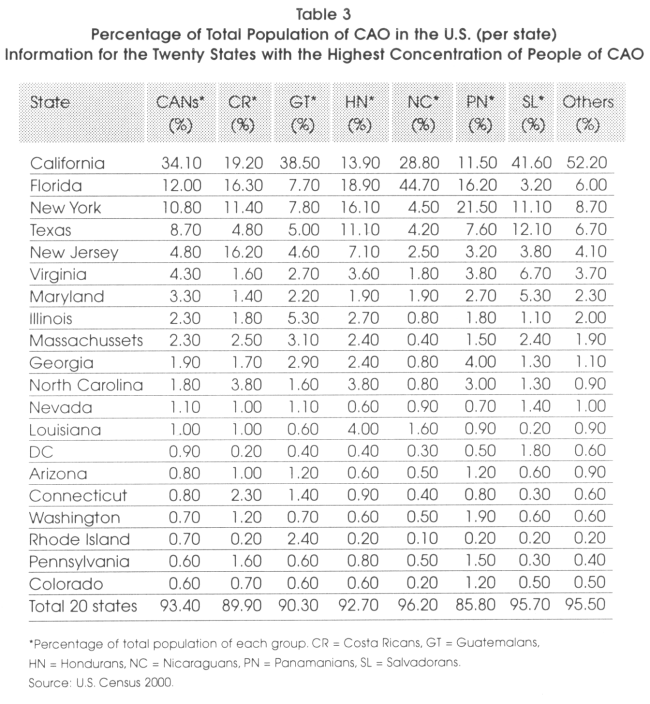
In order to select a state for further study, it is important to take into consideration the actual concentration and not only the total population of CAO in a state. There are states with relatively smaller total population than other states but with a higher concentration of people of CAO than those states with higher total population. It is possible to map the concentration of Central Americans as a proportion of the total population of a state by using U.S. Census data and software to work with GIS files (Figure 2). This information in addition to the information regarding total populations by state helps to determine what states should be selected to further study the Central American populations in the U.S.

Although the total population of CAO in Washington, D.C. represents less than 1 percent of the total population of CAO in the U.S. according to the U.S. Census 2000, the concentration of people of CAO in Washington, D.C. is greater than the concentration of this group in any of the states in the U.S.
3.2 People of Central American Origin by Counties
The counties with the largest concentration of people of CAO in the states with the largest population/concentration of this group were selected. The counties of Los Angeles and Miami account for around 30 per cent of the total CAO population in the U.S. (Table 4). Countries in Table 4 account for almost two thirds of the total CAO population.

3.3 People of Central American Origin by Cities
Within the selected counties, the cities with the largest populations of CAO were selected. Among U.S. cities, the largest number of Guatemalans and Salvadorians lived in Los Angeles; the largest number of Hondurans lived in New York; and the largest number of Nicaraguans lived in Miami-Hialeah3 (Table 5). Since the populations of Costa Ricans and Panamanians who lived in the U.S. are relatively small compared to other CAO populations (see Table 2), Costa Ricans and Panamanians are not considered in this study. Also, their beans exports to the U.S. are small compared to the other CAN countries' exports.
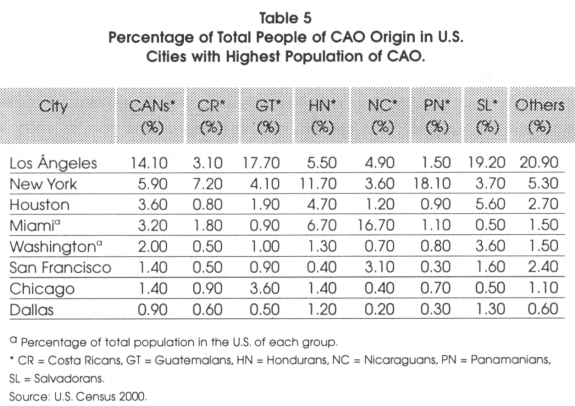
People of CAO tend to concentrate in specific areas within specific U.S. For example, in the Census Tract 25.02 in Washington D.C. (which corresponds to an area of approximately 0 5 squared miles), almost 20 percent of the people are of CAO and in the Tract 28 02, about 28 percent of the people living there are of CAO. These data confirms the high concentration of people of CAO in particular zones in D.C. A similar analysis shows that Los Angeles and Miami also have a very high concentration of this group in specific areas of the city. Those three cities were selected for fieldwork in order to obtain information about the potential market for beans from those countries. In addition, San Francisco and Chicago were also selected for the fieldwork of this research.
4. Small Red Bean and Black Bean Exports
The analysis of secondary data allows assessing the current level of trade between Latin America and the U.S. For the current study, the database of U.S.A. Trade on-line was used to obtain information about trends in bean trade between Central America and the U.S.
Data from U.S.A. Trade on-line (2003), shows that CAN countries grow and export two market classes of beans-small reds and blacks (Martínez, 2003). However, bean exports are often misclassified (e.g., classified as Mungo, Vigna, or Nesoi, i.e., classified as beans, but not assigned to a specific market class) -at the port of entry. After conversations with experts in Central America, it was decided to only include data for beans explicitly classified as reds or blacks in the analysis presented in this section, which focuses on exports of red and black beans from Central America. Consequently, although the data reported in this section underestimates total red and black bean exports, these data are indicative of the relative importance of each market class, as a share of Central America's total bean exports.
Small reds have accounted for almost all of the region's bean exports during the past decade. However, although El Salvador is the region's main exporter of small reds4, in recent years it has also exported small quantities of black beans. In contrast, Honduras and Nicaragua have only exported red beans. Nicaragua has increased its exports to become the second most important player in this market, while Guatemala has decreased its exports of black beans to the U.S. (U.S.A. Trade on-line 2003).
Since the mid-1990s, red beans exports from Central America to the U.S. have increased steadily, rising from about 500 metric tons (MT) in 1996 to about 3,000 MT in 2003. In contrast, black bean exports have remained low throughout the period, but increased to 200 MT in 2003. However, bean exports to the U.S. still account for only a small share of Central America's bean production. For example, in the period 1999-2001, El Salvador, Guatemala, Honduras, and Nicaragua produced an estimated average of 370,490 MT of beans per year (around 249,000 MT of small red beans and around 138,000 MT of black beans) (Martinez, 2003). Thus, only about 1 percent of the region's small reds and 0.1 percent of the region's black bean production were exported to the U.S. in that period. Assuming yields of 0.76 TM/ha, exports were equivalent to less than 1 percent of the bean area.
5. Central American Beans Subsector in the U.S.
5.1 Subsector Participants
A commodity subsector consists of the vertical array of activities associated with the production and marketing of a commodity. This framework allows a better understanding of the current markets for food products. For our case, participants associated with the U.S.-CAN bean subsector, include six groups5: 1) Central American growers firms, 2) Central American wholesalers/exporters, 3) U.S. importers, 4) U.S. distributors/wholesalers, 5) U.S. Hispanic grocery stores/supermarkets, and 6) U.S. Hispanic consumers (Figure 3).
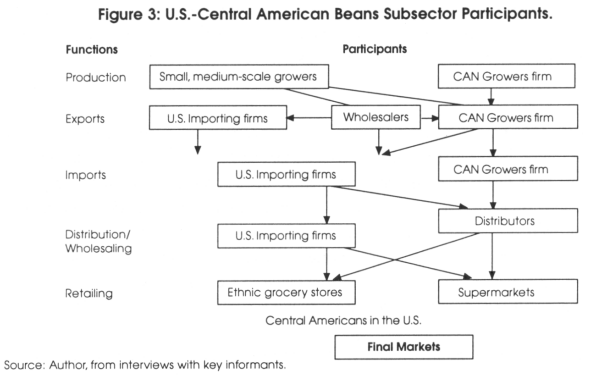
5.1.1 Central American Growers Firms
A limited number of large-scale growers produce beans using the recommended bean production technologies. Often, these growers have agreements with Wholesalers, who ask them to produce specific quantities of specific bean varieties. A few of them, who have the required human, physical, financial and organizational capital, trade directly with U.S. Importers. Some large-scale growers work jointly with Importers or have arrangements with firms in the U.S. to import their beans. In addition, while some of these firms distribute their own products in the U.S., others use U.S. distributors to reach Hispanic markets. For example, Arrocera San Francisco (ASF), based in El Salvador, produces beans, buys beans from other growers, and buys beans from Central American wholesale markets; bag their beans; and export them to U.S. The owners of this firm have a subsidiary in New York (All Foods Inc.), which imports beans from El Salvador and sells them to distributors in the U.S. While it initially targeted markets on the U.S. East Coast, All Foods Inc. is now expanding its operation to the southern and western areas.
5.1.2 Central American Wholesalers/Exporters and U.S. Importers/Distributors
Wholesalers/exporters buy beans from farmers and from other middle-men. Often, they specify quality characteristics such as small reds that are light colored (e.g., silk red beans). The wholesalers which participate in this subsector export beans directly to U.S. importers.
Most of the U.S. importers in this subsector import beans in bulk-usually in 100 pounds (1b) bags- or import beans that are already bagged for retail sales (e.g., 1 lb). Importers are located in or near the U.S. cities with the highest population of CAO, particularly Los Angeles, Miami; Houston, and New York. As noted above. Importers source their beans from CAN firms that grow beans and/or buy beans from Wholesalers in the region. These beans are usually shipped to the U.S. by exporters -typically in containers with other food products. These Importers may have a representative in Central America, who may be associated with a Central America-based firm or who is simply a relative6 who lives there.
Fieldwork identified approximately 30 enterprises that imported beans from Central America. Most of these were small firms, which were owned by people of CAO.
The majority of these firms were located in California (approximately 40 per cent); especially the firms owned by Salvadorans (ten firms) and Guatemalans (two firms). However, the fieldwork also identified firms in Houston (three firms), Washington (five firms), New York (three firms), Miami (three firms), and Chicago (two firms) that also imported beansespecially from El Salvador.
U.S. distributors, who buy beans from U.S. Importers, may bag the product and market it to grocery stores and supermarkets. Distributors may also receive the beans already bagged from the Importers. In addition to beans, these distributors typically sell many different Hispanic products. Distributors have a wide knowledge about the Hispanic food market and some of them have a deeper knowledge of the Central American ethnic market in the U.S.
5.1.3. U.S. Hispanic Grocery Stores/Supermarkets
While most Hispanic groceries/supermarkets in the U.S. target the general Hispanic population -especially Mexicans-stores in the communities visited targeted people of CAO. These groceries sold a great diversity of products of CAO. In these stores, Spanish was the primary language spoken and people who work in these places are of Hispanic origin. While Hispanics owned many of these stores, some were owned by people of Asian/Korean origin (4 of the 30 shops visited), especially in Los Angeles. The Hispanic grocery stores were located in areas with high concentration of people of CAO, and were usually close to each other and relatively small, compared to the supermarkets in the area.
People of CAO shopped in these stores because these groceries belong to many of the products they used in their country of origin. However, some of the Hispanic groceries have become supermarkets, which have more shelf space and sell a greater diversity of products than the typical Hispanic grocery (i.e. 75 to 200 m2) -such as Liborios Markets, a Hispanic supermarket chain in Los Angeles (around 450 m2). in addition, non-Hispanic supermarkets -which are located in the Latin areas visited- also sell beans imported from Central America.
In the five selected cities, 30 Hispanic grocery stores located in the Census tracts with the highest concentration of CAO people were visited and information about availability and prices of more than 30 brands of beans that target the CAN market were collected. The majority of the small red beans labelled as Central American was labelled as Salvadoran (N = 18 of 26 small red bean presentations, 69 per cent), although some were labelled as Nicaraguan (N = 5, 19 per cent), two as Honduran (8 per cent), and one was labelled as CAN but without a specific country of origin7. Similarly, the majority of the black beans were labelled as coming from El Salvador -despite the fact that El Salvador is not a big black beans producer.
Data collected during visits to Hispanic groceries indicates that the average prices per pound varied greatly by market class/type of bean (i.e., black beans, small red beans, and red silk beans). Table 6 differentiates between CAN and Non-CAN beans (i.e., imported vs. domestically produced). On average, silk red beans8 were priced about 50 percent higher (USS 160/lb) than other types of red beans (i.e., CAN and Non-CAN together were priced at an average of US$1.07/lb). However, CAN small red beans were priced at an average of about 50 percent higher (US$1.41 /lb) than Non-CAN beans (US$0.91/lb). Black beans from Central America were priced at around 60 percent higher (US$146/lb) than Non-CAN blacks (US$0.90/lb). These data clearly indicate that consumers who shop in these groceries are willing to pay a premium price for beans from Central America.
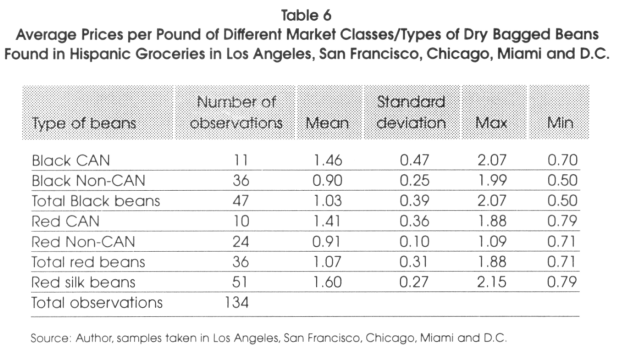
5.1.4. U.S. Hispanic Consumers
A total of 114 CAO consumers were surveyed regarding their bean consumption preferences. About 90 percent of respondents reported that they bought dry beans (Table 7).
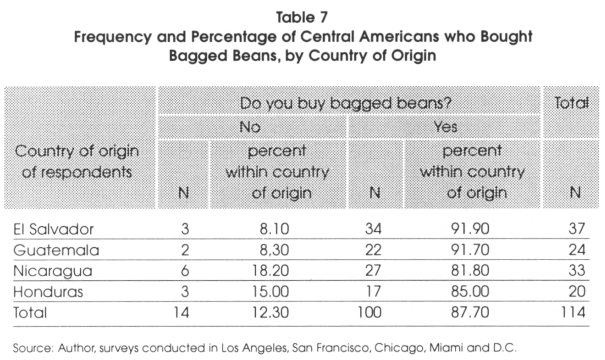
Also, from the survey, less than half of CAO consumers (45 per cent) currently buy beans from their own country and almost two thirds (62 per cent) buy beans from their country or other place in Central America. On average, these respondents who bought beans reported that their household consumed 2.28 lbs. of bagged beans per week. Those Salvadorans who were surveyed reported that their households consumed weekly about 1 lb of silk red beans and about 0.5 lb of small red and black beans from El Salvador.
In general, the sample of respondents consume on average 1.95 lb beans per household per week (this average includes those who consume beans and those who do not consume beans) -about 1 lb from their own country and another 0.5 lb from somewhere else in Central America (Table 8). Hondurans reported that they consumed the smallest amount of beans from Central America; while Guatemalans reported that they consumed the smallest amount of beans from their own country and also consumed a great amount of canned beans. This may be due to Guatemalan's preference for black beans and the availability of black beans of U.S. origin, which are similar to black beans from Central America.
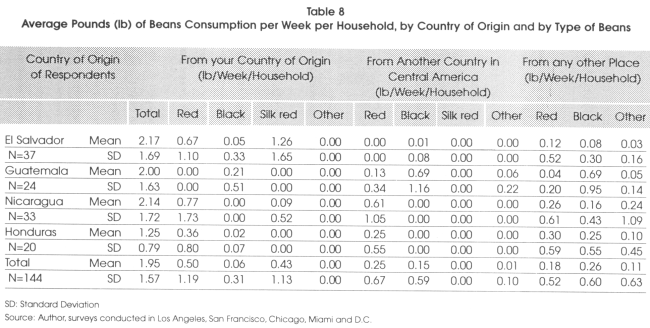
Consumers who bought small red beans were asked what was the major reason that they preferred small red dry beans -between "color", "origin of the beans", or that they were indifferent (i.e., didn't have a preference between those two attributes). Among all consumers, twice as many selected "origin", as those who selected "color". Those results were similar when preferences were analyzed by consumers' specific country of origin (Table 9).
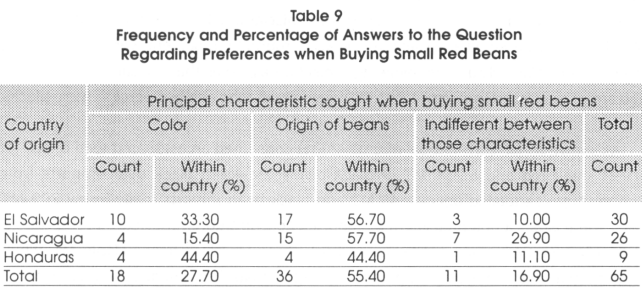
In addition, the consumers were asked if they had a preference for "beans from their country of origin", "beans from any other place in Central America", "beans from anywhere else in the world", or "no preference". More than 80 per cent said that they prefer beans from their country of origin (Table 10). Those results were also similar when preferences were analyzed by consumers' specific country of origin.
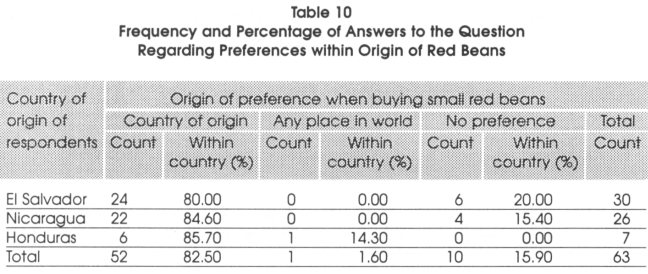
As shown in Tables 9 and 10, people of CAO consider origin to be an important characteristic when buying small red beans. The following analysis estimates the potential U.S. demand for CAO beans, given the Census Bureau's 2003 estimate of people of CAO (Table 2), current consumption of CAO beans as reported by people of CAO (from the survey), the current level of beans imports from Central America (data obtained from USA Trade on-line), and the preference of people of CAO for beans from Central America. As noted before, approximately 35 percent of the 4,754 MT9 of beans imported from Central America in 2003 was misclassified when entering the U.S. Of the total beans classified as small red or black, around 95.6 percent were small red and the rest were black. Thus, the following projection assumes that for each country, 95.6 percent of total bean imports (4,754 MT) were small reds and 4.4 percent were blacks.
As shown in Table 11, people of CAO (2003) consumed an estimated total of 15,941 MT of small red and 6,234 MT of black beans. However, black bean imports from Central America totaled only 4,545 MT and black bean imports totaled only 209 MT. Thus, there exists a potential gap (i.e., reported consumption minus current imports) of 11,396 MT for CAO small red beans and 5,129 MT for black beans (Table 11) -which suggests that that there exists a potentially large unsatisfied demand for bean imports from Central America. Given that 82 percent of people of CAO reported that they prefer small red beans from Central America (Table 10), at least an additional 9,340 MT of small red beans would have to be imported to satisfy people of CAO's current demand for CAO small red beans. Because red and black beans from each Central America country are assumed to be close to perfect substitutes, the estimates of the potential demand from each Central American country are not as important as the estimate for the entire region. These estimates of the potential gap between bean demand and imports are rather "conservative", since the Census Bureau's estimates of the CAO population are conservative, compared to those of the Central American embassies.
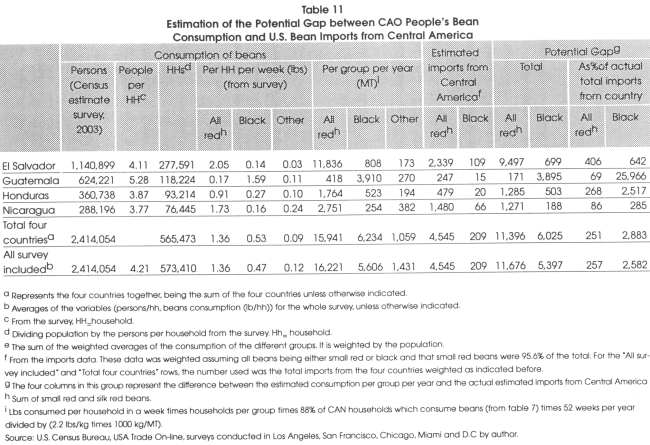
5.2 Dynamics in the Subsector
Most CAN beans sold in the U.S. are imported from El Salvador. The firms that distribute these beans are usually owned by Salvadorans living in the U.S., who mainly distribute regionally -targeting Salvadorans in Los Angeles, Washington, DC, and Houston. For example, Rio Grande's bean brand was found in San Francisco, Washington, DC, and Los Angeles; and La Miguelena's brand was found in Washington, DC, and Chicago. In contrast, Goya's brand was the only one found in every city visited. In fact, Goya had a predominant presence in all of the grocery stores visited. In these groceries, a wide variety of Goya's bean products were sold, including black beans, small red beans, silk Salvadoran red beans, and beans labeled as red beans from Central America. Key informants reported that some of the beans that Salvadoran traders import actually came from Honduras and Nicaragua. However, some Salvadoran traders targeted the Honduran and Nicaraguan market by labeling their imports as Honduran or Nicaraguan beans.
In general, firms market beans to Hispanic groceries through two marketing channels: 1) "importer-driven channels" and 2) "exporter-driven channels".
5.2.1. Importer-Driven Trade
This channel consists of U.S. -based firms, mostly owned by people of CAO, which have established a regional or interregional distribution channel in the US (e.g., Rio Grande and Dubon & Sons). Some of these firms marketed many different food products, targeted U.S. residents of CAO (especially the Salvadoran market), and had representatives in Central America who purchase beans for them -especially from wholesalers. In addition, this group included smaller firms, which only imported beans (primarily from Nicaragua and Honduras) for distribution via regional marketing channels, (e.g., the Miami area). These small firms sourced beans from wholesalers or from their own representatives (relatives) in Central America, who exported the beans to them in the U.S.
5.2.2. Exporter-Driven Trade
This marketing channel consisted of firms in Central America that had grown beans and other products for many years, and had recently begun to export their products to the U.S. These firms, who also bought beans from other growers and from wholesalers, mainly exported beans to distributors in the U.S. Some of these firms had representatives in the U.S. who imported the beans and then sold them to distributors (e.g., Arrocera San Francisco). Many of these firms reported that their principal constraint to increasing exports was a lack of information regarding potential markets and the names of distributors who would be interested in purchasing their products.
6. Constraints and Opportunities
6.1. Constraints
Interviewing importers and exporters allows understanding their major constraints for expanding their volume of trade in this market.
Main concerns raised by CAN exporters included:
1) A lack of knowledge regarding reliable importers/distributor in the U.S., who were interested in establishing a durable and continuous relationship with them;
2) difficulties associated with receiving payments for their products, and
3) problems in meeting importers' volume requirements and being able to supply a product of consistent quality at the time required.
Main concerns raised by U.S. importers included:
1) The varying quality on beans imported/shipped from Central America,
2) small importers said they had problem entering the grocery store market, since they are new suppliers,
3) a lack of knowledge of new markets where they could sell their beans,
4) finding reliable exporters who could supply the necessary volumes and at the time needed.
6.2. Opportunities
This study showed that people of CAO prefer beans from their home country and are willing to pay a premium price for them. While beans from Central America are currently sold in Hispanic groceries, some of the U.S. bean importers surveyed expressed the opinion that there is a potential to increase the market for CAN beans -especially beans from Honduras and Nicaragua. These importers also commented that if they were able to obtain information about the potential market for CAN beans in other U.S. cities, they would increase their sales.
Some of the bean distributors contacted expressed an interest in entering the CAN ethnic food market in the U.S. However, these distributors need information regarding both the location of CAN communities in the U.S. and the names of CAN exporters who could meet their volume, quality, and consistency requirements -which vary among distributors. However, once links are established between CAN exporters and U.S. distributors, both parties could agree on the grades and standards required.
The potential to increase bean exports from Central America is greatest via the "importer driven" marketing channel. Increasingly, U.S. importers recognize the need to move towards greater vertical coordination, due to an inconsistency in the quality of beans supplied by CAN traders. Thus, U.S. importers are beginning to establish agreements directly with large-scale farmers and firms in Central America (Cabrera, 2003). In other cases, importers are creating companies in CAN countries to export directly to the importer. In addition, importers are creating their own distribution channels in the U.S. to market their imported beans.
7. Conclusions
People of CAO (i.e., Guatemalans, Hondurans, Nicaraguans, Salvadorians) living in the U.S. prefer to consume beans that come from their countries of origin. They also consume more dry beans than the average person in the U.S -while the U.S. per capita consumption averaged 7.33 lbs in 2003, (0.14 lbs of small red beans and 0.52 lbs of black beans in 2003, this study shows that people of CAO consumed around 24 lbs of beans, (16.7 lbs of small red beans and 5.8 lbs of black beans). When available, people of CAO are willing to pay a premium price for CAN beans. The concentration of each CAO group varies from city-to-city. In cities with a high concentration of a specific CAO group, it is more likely that Hispanic groceries will sell beans from that specific country.
This study confirms that there exists a significant demand for beans of CAO in the U.S. and this demand is likely to grow in the future. New initiatives are needed to assist Central American exporters to identify new markets in the U.S. and to insure that small-scale farmers in the bean-producing countries benefit from growth in bean exports to the U.S.
First, Central American exports-promotion offices need to play a more active role in assisting CAN exporters to obtain the information needed to assess the demand for food products from Central America. Also, since CAN consulates and embassies in the U.S. interact with hundreds of CANs each week, they could obtain information regarding consumer's preferences by surveying their clients. CAN exports-promotion offices could take a more active role in linking CAN exporters with U.S. distributors, providing U.S. importers with contact information for reliable CAN exporters, and serving as a "representative" for CAN exporters in the U.S. (even with the assistance of consulates and embassies). By taking on the role of a kind of "broker" between U.S. importers or U.S. distributors and CAN exporters, CAN governments could relax many of the current constraints to increasing the presence of CAN beans in the U.S. market. For example, currently, the Salvadoran government works closely with SAL exporters and U.S. importers and distributors to increase the presence of SAL products in the U.S. This initiative represents a successful example from which the other CAN countries could obtain important information regarding how to better target the U.S. Hispanic food market. The CAN private sector has the right incentives to explore and take advantage of this increasing ethnic market in the U.S. Working closely with the exports-promotion offices will allow the CAN private sector to increase its share in this market.
Second, while small-scale farmers are the main producers of beans in Central America, from the interviews with consulates' representatives it was known that these farmers have not benefited from the increase in exports to the U.S. -both because they lack information about the existence of this market and they are unable to meet this market's quality standards. Thus, new initiatives are needed to increase small-scale grower participation in bean exporting.
Limitations
The small consumer sample size is the most important limitation in this study, especially with the sample size for Hondurans. The consumer survey also failed to obtain information regarding the potential increase in demand (if any) for Central American beans when they were more available and regarding other household characteristics such as income level of the consumers. Since this study was based on the rapid appraisal method, the information from importers and distributors could not be analyzed from a quantitative perspective. Improving these limitations will allow researchers to better assess the demand for Hispanic food products in U.S. ethnic communities.
It is also important to study deeper the demand for Central American beans not only by people of CAO in the U.S. but also by the rest of the U.S. population (for example the demand by food chains that could use the small red Central American beans in salads).
Information regarding where the Hispanic grocery stores are located in the U.S. and using GIS software could help to adequately map these grocery stores. This information could help the Latin American exporters and U.S. importers and distributors of Hispanic food to target their products more efficiently and to increase their share in the U.S. food market
Notas
* Miguel Zamora: Graduate Student in the Department of Agricultural Economics at Michigan State University.
Richard Bernsten: Profesor in the Department of Agricultural Economics at Michigan State University.
The research for this paper was funded by the BEAN/COWPEA Collaborative Research Support Program (Grant No. GDG-G-00-02-00012-00).
1 "Hispanics or Latinos are those people who classified themselves in one of the specific Spanish, Hispanic, or Latino categories listed on the Census 2000 questionnaire -"Mexican, Mexican Am., Chicano,' "Puerto Rican", or "Cuban* -as well as those who indicate that they are "other Spanish/Hispanic/Latino." Persons who indicated that they are "other Spanish/Hispanic/Latino" include those whose origins are from Spain, the Spanish-speaking countries of Central or South America, the Dominican Republic or people identifying themselves generally as Spanish, Spanish-American, Hispanic, Hispano, Latino, and so on. Origin can be viewed as the heritage, nationality group, lineage, or country of birth of the person or the person's parents or ancestors before their arrival to the United States, People who identify their origin as Spanish, Hispanic, or Latino may be of any race". (U.S. Census Bureau, 2000).
2 A short definition of Tract is "a small, relatively permanent statistical subdivision of a county delineated by a local committee of census data users for the purpose of presenting data" (U.S. Census Bureau, 2000). These tracts contain streets in an approximately average area of 1 square mile, but the actual area may vary.
3 Table 5 presents "Miami-Hialeah" and "Washington D.C, Arlington, Virginia, and Alexandria City, Virginia" as single locations, due to their geographical proximity.
4 Key informants (Central American exporters, U.S. importers) reported that a substantial share of El Salvador's red bean exports are actually imported from Nicaragua and Honduras and then exported from El Salvador to the U.S.
5 The overviews reported for these sections are based on information obtained by interviewing representatives of Central American consulates in the U.S., U.S. importers/distributors and Central American bean exporters.
6 Some importers reported that purchasing beans from a relative, insures that the beans shipped will meet the importers quality standards.
7 Some of the beans labelled as Central American beans did not seem to be actually Central American beans when compared with samples of authentic Central American beans at Michigan State University.
8 Silk red beans (triples rojos de seda) are a market sub-class of small red bean (i.e.. traditional varieties/landraces). Beans of this sub-market class are generally preferred by Central American consumers and people of CAO in the U.S.
9 As noted before, several brands labelled as CAO beans in the grocery stores were not actually CAO beans. This may explain why the estimate of U.S. bean imports from Central America is smaller than the consumption of CAO beans reported by people of CAO in the survey.
REFERENCES
Batres M., S; H. Jensen, and G. Brester 2003 "Salvadoran Consumption of Ethnic Foods in the United States". Journal of Food Distribution Research. 34 (2): 1-16.
Cabrera, O. 2003. "Nuevo cohete comercial rumbo a EE.UU". El Diario. San Salvador. Consulted on June 12th 2003. Available on: www.elsalvador.com/noticias/2003/2/12/negocios/negoc3.html
Cheskin Group. 2002. "Hispanic Trends. Cheskin's Market Insight Report".
Food Marketing Institute. 2002. U.S. Hispanics: Insights into Grocery Shopping Preferences & Attitudes, Executive Summary. Food Marketing Institute, USA. Consulted on June 5th 2003. Available on: http://fmi.org/pub/summaries/hispanicexecsummary.pdf
Humphreys, J. 2003. "The multicultural economy 2003, America's minority buying power". Georgia Business and Economic Conditions. 63(2): 1-26.
Lucier, G., B. Lin, J. Allshouse, and L. Kantor. 2000. "Factors Affecting Dry Bean Consumption in the United States". Washington, DC. Economic Research Service/USDA.
Martinez, L. 2003. "An integrated assessment of the dry bean subsector in Central America". Thesis for Masters Degree. Michigan State University.
Ministerio de Economía de El Salvador. 2003. "Estudio de mercado de productos étnicos en Estados Unidos: caso de estudio frijol rojo salvadoreño". San Salvador. Ministerio de Economía de El Salvador.
USA trade on-line. 2003. U.S. Foreign commerce Data Base. Consulted on January 18th 2003. Available on: www.usatradeonline.gov. Consulted on September 2nd 2003. Available on: http://www.census.gov/
U.S. Census Bureau. 2000. Hispanic origin. Consulted on June 15 2004. Available on: http://quickfacts.census.gov/qfd/meta/long_68188.htm
United States Department of Agriculture (USDA). 1998. "Continuing Survey of Food Intakes by Individuals (CSF1I)". Washington, D.C. Agricultural Research Service/USDA.














